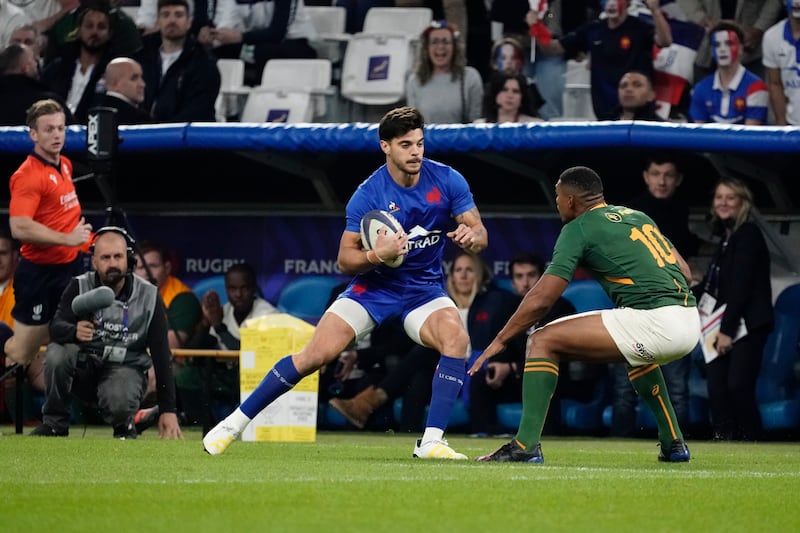Of all the qualities required to be a great attacking outhalf – perhaps the most important and least discussed – is understanding the power that accepting the ball at the appropriate depth has on their team’s attack. Knowing the best depth to receive the ball in relation to the defensive line is the difference between the great number 10s and the also-rans.
The flatter an outhalf stands when taking the ball, the more demands they place on their own skills but crucially they also place huge pressure on the opposition defenders. The deeper the outhalf’s positioning, the more time they have to perform their skill – the trade off is the defence takes away space.
This is known as the gain line theory.
As I have often quoted in the column, gain line theory was created by a handful of rugby geniuses on the Waratahs’ tour of Europe in 1927. It remains contemporary rugby’s driving attacking philosophy.
[ Matt Williams: World Rugby’s meagre list of law reforms wholly inadequateOpens in new window ]
Its principles are simple. The closer the attacker accepts the ball to the defensive line the more pressure the attack places on the defenders. The faster the attack runs at the defence, the slower the defensive line will move forward. Then, as if by magic, all this beautifully counterintuitive thinking creates space.
When the ball is in play, rugby has several imaginary lines that run across the field. The offside line and the gain line are common knowledge, but the least spoken about and most important of these imaginary lines is the tackle line. This is the point where the ball carrier and the tacklers meet.
The deeper an attacking outhalf stands to give himself time when accepting the ball, the closer to his try line the tackle line will be. In other words, he will lose ground. The opposite is also true. The flatter an attacker catches the pass the closer the tackle line will be to their opponents’ goal line. Gain line theory works because it forces the tackle line up the field.
Gain line theory is being executed with excellence at European club level by Leinster and Toulouse. The national teams of France, New Zealand, Australia, Argentina and Ireland are all also playing gain line theory attack.
Johnny Sexton is one of the all-time masters of gain line theory because he is one of rugby’s greatest ever exponents of using variation of his depth to create space.

Sexton and other greats exponents of gain line theory of the past like Mark Ella, Barry John, Phil Bennett and Stephen Larkham learned that by starting slightly deeper then running onto the ball and accepting it flat, then turning their hips square to the try line, they can place huge pressure on the defenders. This is because the outhalf is no longer just a distributor of possession. They are transformed into an attacking threat that the defenders must counter.
Richie Mo’unga, Beauden Barrett, Romain Ntamack and Sexton all put huge pressure on the defenders with the running lines they use before and after they catch the ball.
History tells us that it is no accident that each great running outhalf has been partnered with an equally great scrumhalf with whom they have an almost telepathic understanding. Bennett had Gareth Edwards. Ella had Nick Farr-Jones. Larkham’s partner was the great George Gregan. These legendary scrumhalves all possessed a laser beam pass that placed the ball in front of their number 10 at the exact position and split second where they needed the ball to be.
Aaron Smith has been close to the world’s leading scrumhalf for over a decade and Beauden Barrett and Mo’unga have dominated during that time.
As Sexton’s partner, Conor Murray has at times surpassed Smith as the planet’s finest number nine and now Jamison Gibson-Park is producing astonishing “LQB” (Lightning Quick Ball) for Sexton’s talents to exploit.

In a World Cup year, the rest of the rugby world must respect the French halves. As Antoine Dupont has risen to take over the mantle as the world’s best number nine, Ntamack’s attacking game has accelerated with equal brilliance.
Ntamack is benefiting from Dupont’s skills and now sits alongside any of today’s great attacking 10s.
While gifted with great talents, Marcus Smith has not mastered the art of controlling his depth and so remains consigned to international mediocrity. With England, Smith has constantly aligned far too deep. This has placed England’s attack at a massive disadvantage and was a major factor in the dismissal of Eddie Jones.
If Sexton is injured and unavailable for the opening round of the Six Nations, the next best exponent of gain line theory in Ireland is Ross Byrne. His use of variation of depth is on display week in and week out with Leinster.
Much has been made of the excellent kick that Byrne slotted to defeat the Wallabies. However, it is his knowledge regarding the vital role that the outhalf’s depth plays for both Leinster and Ireland’s attacking systems that are in his favour for selection. His deep understanding of Gibson-Park is also crucial to a fluent Irish attack.
While many would suggest that Joey Carberry is the most likely to take over if Sexton is injured, his use of variation of depth and moving onto the pass at pace, then getting his hips square after accepting the ball to place pressure on the defenders are the aspects of international-level outhalf play that he has struggled with the most.
In the final two pool matches of the Heineken Cup, Byrne has the opportunity to show that he should be given a shot at redemption. If he can display that his command of gain line theory attack is second only to the great Johnny Sexton, then he is worthy of another selection in the number 10 jersey for Ireland.
















